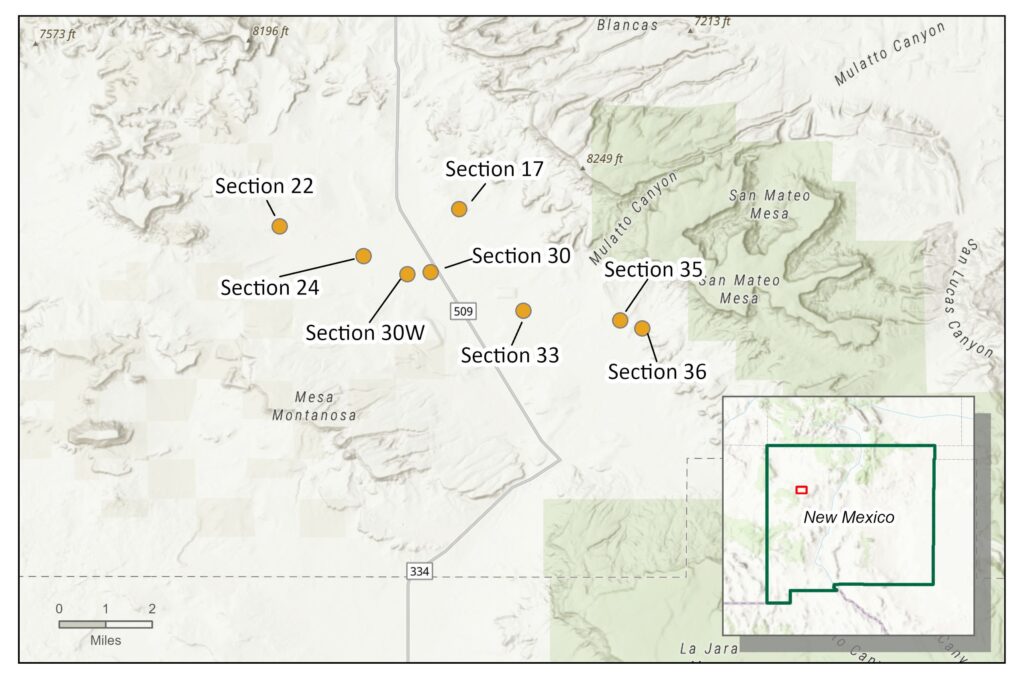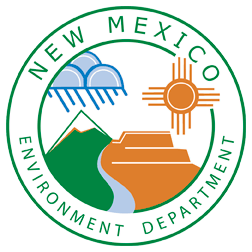LOCATION
Sections 17, 22, 24, 30, 30 West (W), 33, 35, and 36 mines are at eight different locations in the Ambrosia Lake mining subdistrict near Milan, New Mexico. Sections 17, 22, 24, 30, 30W, 33, and 35 spans Township 14N; Section 36 is located in townships 13N and 14N.

Ownership and History
Sections 17, 22, 24, 30, 30W, 33, 35, and 36 mine sites were previously owned and operated by the Kermac Nuclear Fuels Corporation, a partnership of Kerr-McGee Oil Industries, Inc.; Anderson Development Corporation; and Pacific Uranium Mines Co. The Kermac Nuclear Fuels Corp Quivira Mining Co., a subsidiary of Kerr-McGee Corp., took over operations in 1983 (note, in 2006, Kerr-McGee created the subsidiary company Tronox Incorporated that took over liability for the mine sites; see section below on Coordination Between State and Federal Agencies for more information). Rio Algom Mining, LLC. (RAML), purchased Quivira Mining in 1989. RAML was purchased by Billiton in 2000 but remains a subsidiary of BHP Billiton. RAML currently owns the mine sections noted above. Uranium ore was extracted from underground workings and milled at the Ambrosia Lake West Mill (ALW) from 1958 through 1985. For additional information on the Ambrosia Lake West Mill, see the Ambrosia Lake West Mill site review.
Section 17, 22, 24, 30, 30W, 33, 35, and 36 mines were underground, conventional room, and pillar mines that intercepted groundwater. Pumping groundwater was required to develop the underground mining operation. The groundwater exceeded water quality standards and required treatment prior to being discharged. Ion exchange (IX) facilities and settling ponds were installed to treat mine water prior to discharge. The conventional mining, groundwater pumping, and treatment occurred at Sections 17, 22, 24, 30, 30W, 33, 35, and 36 mines between 1958 and 1985.
To recover additional uranium from an area that had previously been conventionally mined, Kerr-McGee used a method of stope leaching to recover an additional approximately 30% of uranium resources. Stope leaching involves circulating a leach solution through the stope to dissolve the remaining uranium. The resulting solution is then pumped to the surface, where the uranium is removed, and the leach solution is then recirculated. Stope leaching occurred at various mined sections on site.
Sandfill operations occurred at Section 22, 30, 30W, 35, and 36 mines. Sandfilling is a process of using mine tailings to fill mined-out stopes to prevent caving or subsidence while mining continues.
Reclamation & Regulatory Jurisdiction
The New Mexico Energy, Minerals, and Natural Resources Department (EMNRD) Mining and Mineral Division (MMD) and the New Mexico Environment Department (NMED) are the state agencies with regulatory jurisdiction over the Rio Algom Mine sites. The reclamation goal for Section 17, 22, 24, 30, 30W, 33, and 35 mines is full release from MMD, completed groundwater abatement activities under NMED, and long-term monitoring also under NMED. NMED is currently working with RAML and other regulatory agencies on overlapping jurisdiction. All RAML discharge permits, or DPs, are not reflective of current site conditions. NMED and RAML are determining the permitting future for the site as it moves toward full closure.
The tailings impoundments and adjacent areas are under DP-169 which also has a groundwater monitoring program. NMED is currently working with RAML to update the Sampling and Analysis Plan for groundwater monitoring under all DPs.
Regulatory Tracks
- Discharge permits DP-362, DP-67, DP-264, DP-71are registered with NMED.
- All discharge permits are under Stage 1 Abatement.
- Section 17, 22, 24, 30, 30W, 33, and 35 mines are under an Existing Mine Permit MK009RE.
NMED
DP-362. In 1983, The Environmental Improvement Division of the New Mexico Health and Environment Department (HED-EID, the predecessor of NMED) determined that the old stope leaching process described above would require a discharge permit under the New Mexico Water Quality Control Commission Regulations promulgated in 20.6.2.3000 New Mexico Administrative Code (NMAC). HED-EID issued DP-362 in 1985. DP-362 has had timely renewals and approvals since 1985, with the most recent application for renewal submitted in 2012. At this time, DP-362 is administratively continued while NMED and other regulatory agencies determine jurisdiction of the mines. DP-362 authorized old stope leaching at Section 17, 19, 22, 24, 30, 30W, 33, and 35 mines and includes monitoring and reporting requirements. Groundwater abatement for facilities and activities under DP-362 began in 2008. DP-362 also includes closure requirements. In 2020, NMED and MMD worked with RAML to develop an interim closure plan. This plan updated the financial assurance and established general practices to be implemented at final closure.
DP-67. In 1985, HED-EID issued DP-67, which authorized discharge of mine water from the IX facility and treatment ponds from the Section 35 and 36 Mines and associated monitoring, reporting, and closure requirements. Timely renewals of the permit were submitted through 1997, when the permit was last renewed. The permit is administratively continued at this time. Groundwater abatement for facilities and activities under DP-67 began in 2008. In 2020, NMED and MMD worked with RAML to develop an interim closure plan. This plan updated the financial assurance and established general practices to be implemented at final closure.
DP-264. HED-EID issued DP-264 in 1983. DP-264 is for backfilling activities in Section 35 and 36 mines. Kerr-McGee submitted timely renewals of the permit through 1990, when the permit was last renewed. Monitoring, reporting, and closure requirements are also a part of DP-264. Abatement activities under DP-264 are addressed in DP-362. In 2020, NMED and MMD worked with RAML to develop an interim closure plan. This plan updated the financial assurance and established general practices to be implemented at final closure.
DP-71. DP-71 authorized discharge of fluids from ALW and associated mines into 11 evaporation ponds in Section 4. DP-71 was first issued by HED-EID in August of 1979. Kerr-McGee submitted timely renewals through 2003, when the permit was last renewed. DP-71 is administratively continued and remains an active permit. Monitoring, reporting, and closure requirements are also a part of DP-71. Abatement activities under DP-71 are addressed in DP-362. In 2020, NMED and MMD worked with RAML to develop an interim closure plan. This plan updated the financial assurance and established general practices to be implemented at final closure.


EMNRD-MMD
Section 17, 22, 24, 30, 30W, 33, and 35 mines are all under the Existing Mine Permit MK009RE. MMD is holding joint financial assurance with NMED based off an interim Closure/Closeout Plan. Reclamation at these sites is not complete due to ongoing negotiations with the U.S. Environmental Protection Agency (EPA) and the U.S. Nuclear Regulatory Commission (NRC) associated with the Tronox settlement and San Mateo Creek Basin regional work. See Section D. Unique Situation: Tronox for more information on the Tronox settlement. Section 36 mine is prior reclamation released by MMD, but additional surface work may be required under NMED

Closure/Closeout Plan
Reclamation began on Section 17, 22, 24, 30, 30W, 33, and 35 mines in 1994 under the Prior Reclamation Criteria of the New Mexico Mining Act (NMMA) Rules (19.10.5.511 NMAC). Additional surface reclamation work occurred at the Section 17, 22, 24, 30, 30W, 33, and 35 mines from 2003 through 2005 under an Existing Mine Permit (MK009RE) through the NMMA Rules (19.10.5. NMAC) with EMNRD. The Existing Mine Permit required that Quivira Mining develop an approved Closeout Plan. In 2003, RAML performed additional reclamation work under the Closeout Plan, which included further demolition and disposal of surface facilities, contour work and revegetation of the surface, and plugging of the main shaft, ventilation holes, and injection holes. Section 17, 22, 24, 30, 30W, and 33 mines have not yet been released by EMNRD from requirements of the NMMA and remain subject to permit number MK009RE, which was updated in 2021. Most formerly active operational mine structures have been removed from the sites, but soil cleanup is not complete due to residual uranium contamination.
NMED and EMNRD-MMD approved a Revised Interim Closure/Closeout Plan in November 2020 that addresses closure activities associated with DP-362, DP-71, DP-67, and DP-264, as well as ongoing surface reclamation covered under EMNRD-MMD.
Timelines for the Completion of Cleanup Activities
Reclamation and abatement actions are planned to continue for the foreseeable future and the estimated date of completion is unknown.
Coordination Between State and Federal Agencies
The NRC is the regulatory agency responsible for managing uranium beneficiation byproduct material. At some RAML mines, byproduct material is comingled with mining-related material. The NRC is determining whether it has jurisdiction over comingled impacts. EPA Regions 9 and 6 are the signatory of the Tronox settlement agreement. Tronox Incorporated is a spinoff company created by Kerr-McGee Corporation. All RAML mines are considered Tronox mines. RAML is under ongoing negotiations with EPA regarding fiduciary distribution of the money in the Tronox settlement for the cleanup of mines (for more information on this settlement, see Section D. Unique Situation: Tronox in the strategic plan). NMED and MMD are participating in the discussions regarding the Tronox settlement and NRC jurisdiction.
RAML held a National Pollution Discharge Elimination System Permit No. NM0020532 to discharge mine drainage, surface and groundwater reclamation wastewater, and stormwater from the Ambrosia Lake mining area.
Anticipated Funding Requirements
Funding for all site reclamation, abatement, remediation, and long-term monitoring actions regulated by NMED and EMNRD-MMD are covered by RAML, the responsible party for Sections 17, 22, 24, 30, 30W, 33, 35, and 36 mines. The Office of Natural Resources Trustee is working with RAML to develop an approach for a cooperative natural resource damage assessment and an evaluation of restoration options to compensate for any identified resource injuries and service losses caused by releases of hazardous substances at the site. This work will be separate from all permitting activities that NMED and MMD conduct. NMED and EMNRD-MMD jointly hold financial assurance totaling $89,340,000.
Disclaimer
Site reviews in this report provide the reader with a general history and status of permitted mines and mills. For brevity, they may not provide all relevant details or agency actions related to each site.

